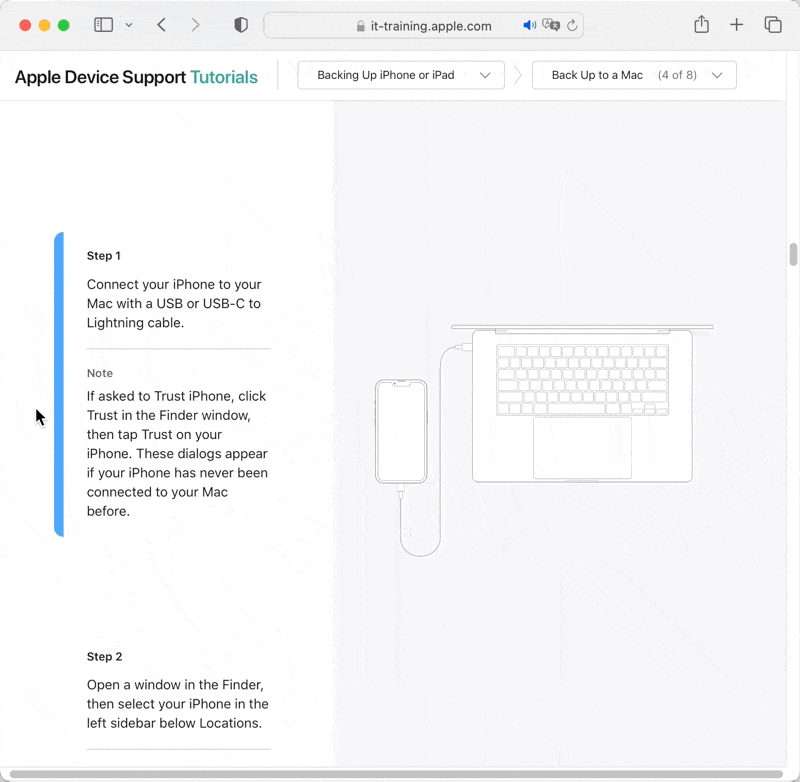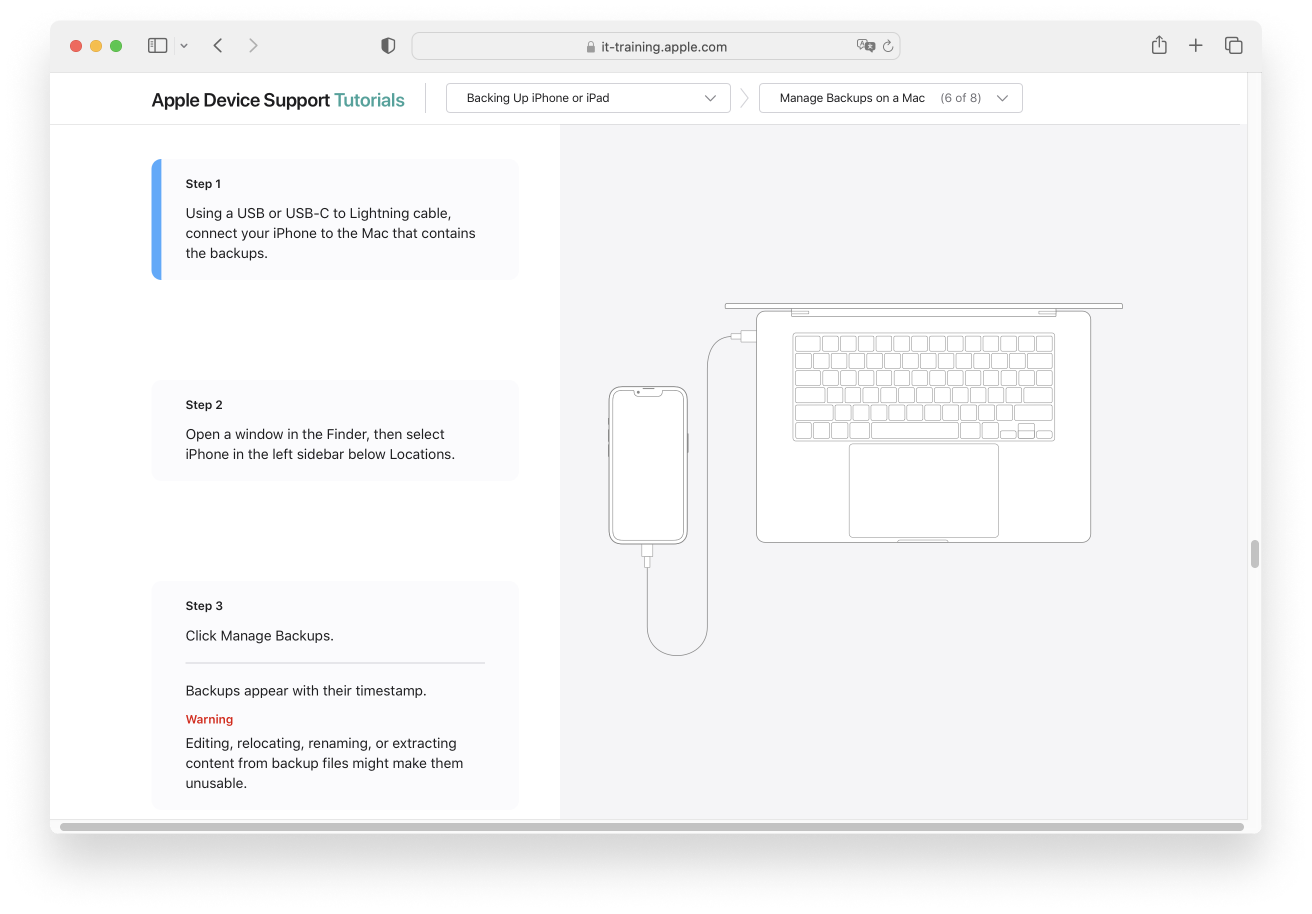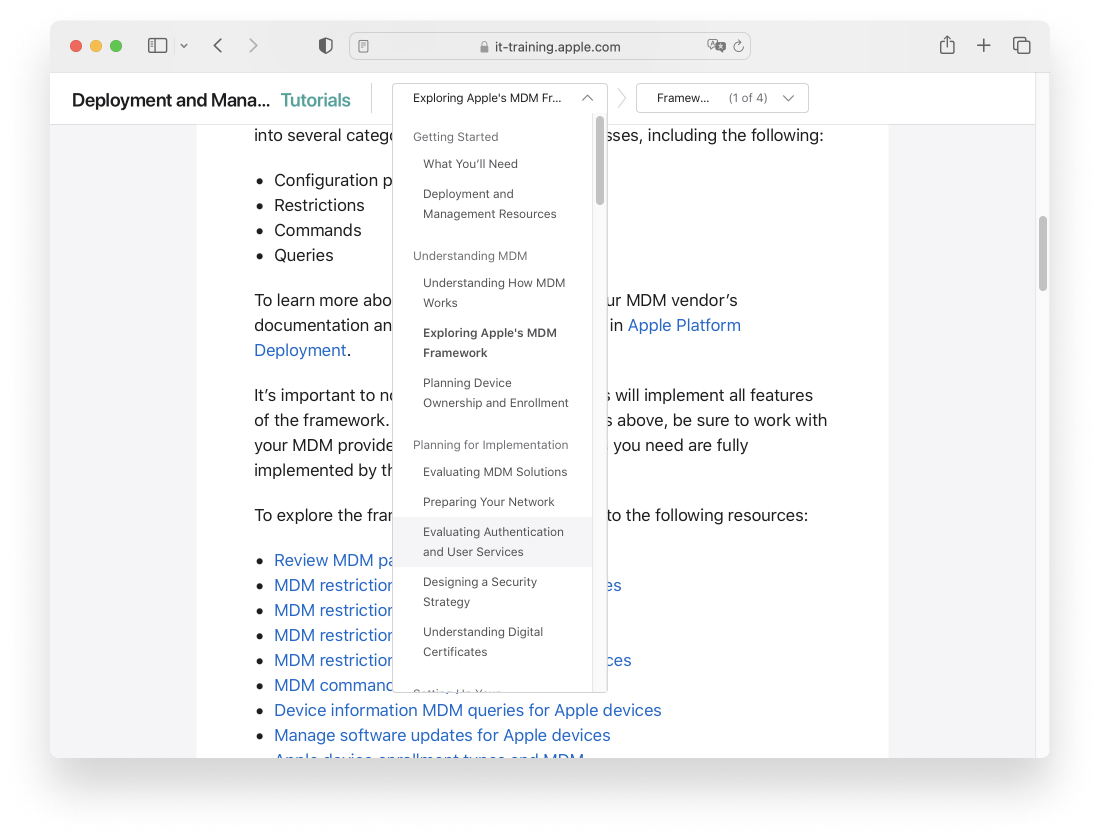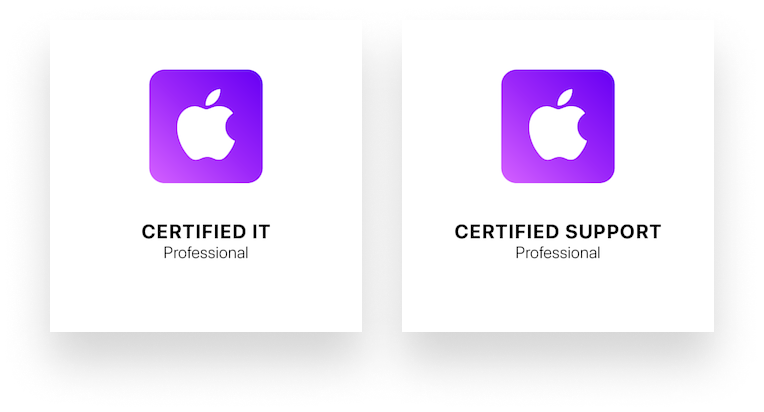Apple IT Training and Certification: What You Need to Know
 Arek Dreyer
Arek Dreyer
Back in May 2022, Apple announced a new series of online IT training and certification programs. These programs follow three tracks: Apple Device Support, Apple Deployment and Management, and Apple Business Essentials.
The first is great for anyone who supports Apple devices and the people who use them. It’s a foundation for the second, which is a great resource for people who deploy Apple devices, especially in the context of mobile device management (MDM). The third is great for anyone who is evaluating or getting started with Apple Business Essentials (which combines device management, 24/7 support, and cloud storage.)
The promise of these training programs: “Apple training delivers everything you need to learn about the technology—online and on your time. Own your learning schedule with self-paced, online courses. Take proctored certification exams from your home or office. And after you’ve passed an exam, display your verified digital badge on any professional networking site.”
I worked my way through the first two courses and was really impressed; I’d encourage anyone in the business of Apple device management to check them out. Here’s an overview of what the courses cover and what the exams are like.
Apple IT Training: The Old Way
Just to provide some context: Before joining Kandji in 2021, I co-authored several Apple training books and courses that supported the official training and certification programs Apple offered then. The last book I worked on was macOS Support Essentials 11 – Apple Pro Training Series: Supporting and Troubleshooting macOS Big Sur. It was the companion to a three-day, instructor-led, hands-on course.
One of the challenges of the printed book format was that we couldn’t provide dynamic illustrations to illustrate a series of steps. We could provide progressions of screenshots, but we faced a physical limitation: Each screenshot took up space on a page, and we had a limited number of pages available. (The last book I worked on was 975 pages long.) The printed format was not ideal for the material.
What Are Apple's IT Training Courses Like?
Apple’s online training format overcomes those print challenges. For example, the courses make great use of animations, which illustrate steps you’d take to accomplish a task on an Apple device or in an MDM solution.
As you scroll through a given tutorial, your web browser window displays the steps and their context, along with accompanying figures or screenshots. Many of the illustrations highlight the relevant portion of the screen.
For example, in the “Backing Up iPhone or iPad” tutorial, backing up to a Mac is illustrated in nine steps.

There are, however, some trade-offs with the online format versus the instructor-led experience.
In the old in-person or virtual-group formats, students could ask for clarification on the ideas or procedures being discussed; get assistance from an instructor if something unexpected happened during an exercise; and, best of all, have real-time discussions with others in the class to share experiences, victories, and mistakes that everyone could benefit from.
The online format does have other advantages. You can go through the materials at your own pace in a location of your choosing. You don’t need dedicated test equipment (unless you want to be hands-on), because Apple provides those great animations.
Apple also makes it easy to zero in on the course materials that are specifically relevant to the tasks your IT team needs to perform. From the Apple Training homepage, select the course you’re interested in, scroll to the bottom of the page, then, in the Get Started section, click the View Course link.
IT Training: Apple Device Support
For example, if you choose Device Support (the first course in the progression), that View Course link leads to Learn How to Support Apple Devices. That page says it will take an estimated 14 hours and 30 minutes to complete the course. It also has an interactive table of contents, divided into five areas:
- Introduction
- Getting Started
- iPhone and iPad
- Mac
- Exam Preparation
You click an area's title to see the chapters within it. For example, that Mac area has four chapters:
- Setting Up and Restoring Mac
- Managing Network and Sharing on Mac
- Managing Privacy and Security on Mac
- Using Diagnostics on Mac
Each such chapter has several bite-sized tutorials, each with an associated time estimate. For example, the chapter on "Managing Privacy and Security on Mac" includes four tutorials, with time estimates for each:
- Turning On FileVault (15 minutes)
- Managing Privacy on Mac (20 minutes)
- Managing Mac Sharing Preferences (40 minutes)
- Using Find My on Mac (45 minutes)
Each of those tutorials, in turn, includes several sections. For example, the tutorial "Managing Privacy and Security on Mac: Turning On FileVault" contains:
- Prepare for the Exam
- Set Up for This Tutorial
- Choose Your FileVault Recovery Option
- Learn About FileVault Secure and Bootstrap Tokens
- Turn On FileVault

Each of those tutorial sections may, in turn, have substeps of its own. Each step is illustrated with graphics. As you work through the tutorials, you may find it helpful to first read through the steps to get an understanding of what to expect, then perform the steps on your own test Apple devices. Such repetition can really help to reinforce the concepts.
Each tutorial includes a "Check Your Understanding" section with a few questions that you should be able to answer after completing the tutorial.
IT Training: Apple Deployment and Management
The second course in the progression, Apple Deployment and Management is set up similarly. Apple estimates it will take 12 hours to complete. The main areas of this course are as follows:
- Introduction
- Getting Started
- MDM Planning
- MDM Preparation
- Device Enrollment
- Device Management
- Device Redeployment and Recycling
- Exam Preparation
- Mac Security Compliance (Note: The exam doesn’t cover this one.)
Again, each one of those areas contains chapters, which in turn contain their own tutorials. The menus at the top of the browser window are useful for quickly navigating through different parts of the course.

Preparing for the Apple IT Certification Exams
As you see, each course has a dedicated "Preparing for the Exam" tutorial. Each of those tutorials includes a review of the course’s learning objectives as well as a section in which you can practice with sample questions. Apple Device Support’s has 99 sample questions, Apple Deployment and Management’s 113.
While Apple supplies those time estimates for completing each course, it also says, “You may need 30 to 60 hours to prepare for this exam, depending on your background, technical expertise, and experience.” Depending on the course, that would mean experience either supporting or deploying and managing Apple devices.
The point is that just taking the courses isn’t enough. Apple says, “To pass the exam, you need to study multiple Apple resources and gain
practical experience,” either in support or deployment and management. They aren’t kidding about this; you’ll especially want to spend time on those other materials. There are extensive links to them from within the tutorials.
Note: As of December 19, 2023, the courses I took—which were based on macOS 13 Ventura and iOS/iPadOS 16—were replaced with a new set focusing on macOS Sonoma and iOS/iPadOS 17.
Taking the Apple IT Certification Exams
Although the courses are free, you’ll have to pay $149 to take each exam. (If you're already certified on one version of an OS, you get a $50 discount when signing up to take an exam for a later version.) Apple writes and maintains the exam questions but works with a third-party organization to administer and virtually proctor the tests.
It’s really difficult to write good and relevant exam questions, which include the question, the correct answer, and the incorrect answers (distractors). The team at Apple that built these exams did a great job. They have a good mix of questions that come directly from the course material and those that are pulled from the additional resources.
You can take the exam from your home or office; you don’t have to worry about traveling to an external training site, but you do have to provide an appropriate space to take the exam.
In order to take the exam, you may have to take photos of your room—four photos in total, from the front, back, right side, and left side of your desk. You may have to use a webcam to allow a proctor to monitor you while you take the exam. For my second exam, I was surprised that, when I started, a proctor said hello and asked me to use the webcam to quickly show them my keyboard and desk space. I agreed to do so in order to take the exam, but you should consider the privacy implications if you’re going to require someone else on your team to take and pass these tests.
Note: When these programs were originally released, you had to pass the Apple Device Support exam before you could sign up for the second Apple Deployment and Management exam. But this year, Apple waived that requirement; as of December 20, 2023, candidates could register for the Deployment and Management exam without first passing the one for Support.
Also: I took my exam on a recently-erased Mac with absolutely no security or management software installed. Be sure to check out the OnVue testing page—that's the company that administers the Apple tests—for details and access to their system test tool. Based on some community comments, I would avoid using a Mac with macOS 14 Sonoma for now and stick with the latest version of macOS 13 Ventura.
Earning an Apple IT Certification Badge
When you pass an exam, you get to use the Credly platform to share your digital badge.
You might be wondering whether this is a certification or a badge. Well, it’s both. Traditionally, many technology companies issued certifications. These were often paper printouts that got mailed to you, which you could then display on your wall and maybe add to your email signature. Over the past few years, badging has become the modern alternative to such traditional paper certificates. They have many advantages.

According to Credly, a badge (often referred to as a digital badge or open badge) is, “a digital representation of a learning outcome, experience or competency.” Badges can be issued for just about anything and could have very simple requirements to earn. Other badges, such as the Apple IT certification badges, have stricter requirements and attest that an individual meets specific criteria.
The best part about digital badges is that you can share them on social networks where potential employers can see them. Each badge contains a link to a description of who the badge is designed for and what they did to achieve it:
- The Apple Device Support leads to an Apple Certified Support Professional digital badge: “The Apple Certified Support Professional badge recognizes knowledge of the tools, services, and best practices used by a help desk professional, technical coordinator, or service provider who supports Mac, iPhone and iPad users, manages networks, or provides technical support for Apple devices.”
- The Apple Deployment and Management course leads to an Apple Certified IT Professional digital badge: “The Apple Certified IT Professional badge recognizes the understanding of the tools, services, and best practices used to deploy, secure, and manage Mac, iPhone, and iPad at scale in organizations. Individuals who have earned this badge demonstrate understanding of the concepts covered in the Apple Deployment and Management course. This badge builds on the Certified Support Professional badge, a required pre-requisite.”
Are They Worth It?
For individuals, these courses and exams are great resources for career growth. For organizations, they can help reduce support costs, run a more effective IT organization, and have happier and more productive users of Apple devices.
Apple’s online platform for courses is encouraging to see. Apple can deliver dynamic content online and offer certification exams no matter where the test-taker is located.
These two courses and exams represent an excellent investment of time and effort on Apple's part. The teams that put these together did a great job. We encourage any Apple admin to use the free course material and consider taking one or both exams.
Editor’s note: This article originally appeared October 21, 2022. It has been updated to reflect the current course material.
